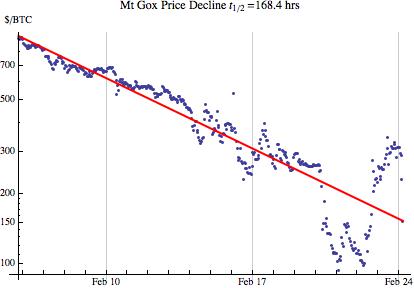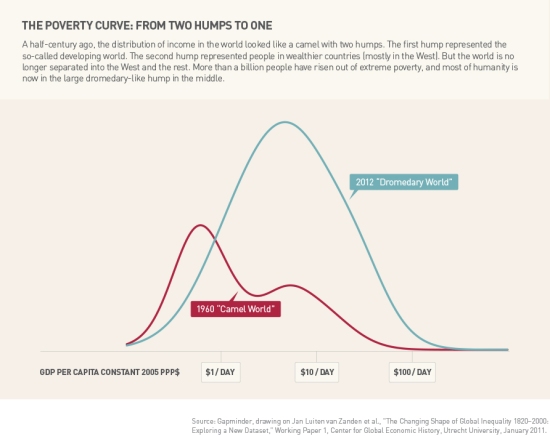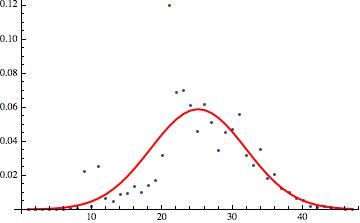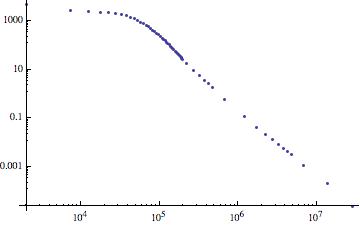I am grateful to see the Bill and Melinda Gates foundation identify three myths that affect the global poor. I will clarify the first myth–providing additional insights. If our goal is to end global poverty there are two things that we must do, unfortunately both are not included in the Gates Letter. We must increase global energy consumption and we must increase individual liberty. I provide a technical justification for cryptography and nuclear energy as paired solutions to end global poverty. I also show how these are fundamental drivers for human progress.
We begin with the global income distribution.
Examining the chart we see that the income distribution in 2000 is  . where
. where  and
and  . When we look at that transition of the income distribution from a mixture to a non mixture we should take great solace. Globalization and global communication united the world. As Hans Rosling says, there is no us and them there is we. In a previous post, I hypothesized that the world reached an equilibrium state. This figure when in consideration with the entropy of the United States shows our world clearly as being in equilibrium,
. When we look at that transition of the income distribution from a mixture to a non mixture we should take great solace. Globalization and global communication united the world. As Hans Rosling says, there is no us and them there is we. In a previous post, I hypothesized that the world reached an equilibrium state. This figure when in consideration with the entropy of the United States shows our world clearly as being in equilibrium,  .
.

Figure 2. United States entropy from 1990–2012 using various deflators.
Getting back to the global income distribution, we need to consider Adam Smith’s statement that “[w]herever there is a great property, there is great inequality”. We see that globally we have a great property and that as a result we have inequality. I am of Smith’s mind, that inequality is. It does not in and of itself carry a value judgement. If we apply a normative value that everyone should have the same income we see that we destroy wealth, property and freedom. I derive these consequences in Various Properties of the Log–Normal Distribution. Let me say this again just to make sure that you heard correctly.
When we adopt Rawl’s position of distributive justice, we demand the destruction of wealth, private property, and freedom. I believe that humanity is fundamentally a good in the world. I am a humanist, and as such I adopt the normative principle that humanity should be preserved and not destroyed. We can avoid such normative judgements and accept a positive one, that the dynamical systems tend to the point of maximum entropy. My basis in this is well founded, it is also the “most honest” assumption that assumes nothing beyond the data given. [Jaynes 2006]
The entropy of a log-normally distributed variable is given by:
![S=\frac{1}{2}\mathrm{ln}\left[2\pi e\sigma^2 e^{\frac{\sigma^2}{2}}\right]+\mathrm{ln}\left[E\left(I\right)\right]](https://s0.wp.com/latex.php?latex=S%3D%5Cfrac%7B1%7D%7B2%7D%5Cmathrm%7Bln%7D%5Cleft%5B2%5Cpi+e%5Csigma%5E2+e%5E%7B%5Cfrac%7B%5Csigma%5E2%7D%7B2%7D%7D%5Cright%5D%2B%5Cmathrm%7Bln%7D%5Cleft%5BE%5Cleft%28I%5Cright%29%5Cright%5D+&bg=f4f3f3&fg=666666&s=0&c=20201002)
We see that for any given  that entropy is maximized by
that entropy is maximized by  . Our global
. Our global  in 2000. This suggests some stark realities that we face. First is that our global carrying capacity is structurally suppressed, based on observed trends in society, I think this is best explained by reduced economic freedom globally. There are various explanations as to why, but it all comes back to government intervention in our lives. Government is an entity that is logically independent from the governed, formally government is orthogonal to the people around the globe. Thus government can act on society exerting force (literal and figurative) on the citizens. Such forces can only exist outside of the system being observed, which is why I reach this conclusion. Said differently, people will act to maximize their freedom given the constraints that they face. Government, by definition, is a constraint on society.
in 2000. This suggests some stark realities that we face. First is that our global carrying capacity is structurally suppressed, based on observed trends in society, I think this is best explained by reduced economic freedom globally. There are various explanations as to why, but it all comes back to government intervention in our lives. Government is an entity that is logically independent from the governed, formally government is orthogonal to the people around the globe. Thus government can act on society exerting force (literal and figurative) on the citizens. Such forces can only exist outside of the system being observed, which is why I reach this conclusion. Said differently, people will act to maximize their freedom given the constraints that they face. Government, by definition, is a constraint on society.
There is a reason why liberty is now a global issue and why we are seeing revolutions and rebellion around the world. The world’s population wants  government wants
government wants  as it can use the entropy difference to extract wealth from society. It is, as it always was, about control.
as it can use the entropy difference to extract wealth from society. It is, as it always was, about control.
Rawl’s philosophy formally justifies  . While this gets us in the direction towards
. While this gets us in the direction towards  it does so at the expense of our liberty. Rawls’ philosophy (progressivism) and that of our current governments (conservativism), are fundamentally limited, both resulting in lower overall societal entropy.
it does so at the expense of our liberty. Rawls’ philosophy (progressivism) and that of our current governments (conservativism), are fundamentally limited, both resulting in lower overall societal entropy.
After we acknowledge the canonical trend of  , we are left with one alternative for increasing entropy, increasing average global income. Governments around the world recognize this which is why they print so much money. Don’t be fooled. increasing the money supply without actually increasing individual productivity, actually is a net harm to society cooling individual action. It is theft at the grandest scale.
, we are left with one alternative for increasing entropy, increasing average global income. Governments around the world recognize this which is why they print so much money. Don’t be fooled. increasing the money supply without actually increasing individual productivity, actually is a net harm to society cooling individual action. It is theft at the grandest scale.
Armed with that understanding we need to answer, “how do we increase individual productivity?” First we need to understand the natural constraints that we face. Our world is governed by the laws of thermodynamics. If we want to increase the amount that we do, we have no option other than to increase the energy consumed by society. This is a first law statement. We can make second law (efficiency) improvements, but these are limited by our knowledge, materials and capital; only resulting in marginal improvements.
Let’s provide a lower bound for the amount of energy we need to raise average global income from the $5.6/day (2000 dollars) to say $56/day (2000 dollars). Because of the second law we know that we have to supply more energy (heat) than is needed to increase the useful work output. Part of this is necessary to overcome hysteresis (stable dynamical systems tend to resist change). We assume the lower bound of energy needed to increase global wealth a factor of 10 to be a factor of 10 from what it was in 2000.
In 2000 the 6 billion people on the planet consumed 120 PW-hr, or 20 MW-hr/person. For a global population of say 10 billion with an average daily income of $56/day (2000 dollars) the world would have to consume 2,000 PW-hr every year! To provide context to this number, in 2008 the world consumed 117 PW-hr of fossil fuels, which is just off the peak fossil fuel consumption of the world. 117PW-hr/year is a daily consumption of 190 million barrels of oil equivalent (MMbbloe/day), or 68 billion bbloe every year.
Scaling fossil fuels to be 82% of a global energy consumption of 2,000 PW-hr/yr is one trillion bbloe/yr. This scale of energy consumption is not possible for fossil fuels. If it is not possible for fossil fuels then it is certainly not possible for renewable energy. We have one option left, nuclear energy.
Assume for the sake of argument the entirety of the 2,000 PW-hr/yr comes form nuclear. How much uranium is needed? Not as much as you might think, 300,000 metric tonnes of heavy metal (MTHM). Known reserves of uranium total 5 million MTHM at <$130/kg. This is terrestrial energy with conventional mining in existing mines. Once price increases far enough there are billions of tonnes of uranium in the oceans.
We have thousands of years of uranium available and as much if not more thorium. Accessing the fuel needed to sustain humanity, support global population, and increase human wealth is not a problem. It never was a problem, nor will it be a problem for any foreseeable future.
If we want to make the poorest amongst us (globally) as rich as the global mean, we need as much power every year as humanity ever consumed in its entire history. We have the capability to access that power today!
I think the term of a “Nuclear Renaissance” is quite fitting. I talked about humanity at the cusp of a second social Renaissance due to recent cryptographic advances. As I understand the world cryptography and nuclear power are going to be the fundamental drivers of humanity. They will end this neo-feudal fossil era. We live in interesting times.

 If I were a VC, and I saw my capital having the potential half life of a week, I would take great pause. Burning the cash would be more effective. So what can I do to be comfortable with my investment? Well, I could pay someone for their advice. But who is an expert on Bitcoin. There is this foundation, but they just develop the code.
If I were a VC, and I saw my capital having the potential half life of a week, I would take great pause. Burning the cash would be more effective. So what can I do to be comfortable with my investment? Well, I could pay someone for their advice. But who is an expert on Bitcoin. There is this foundation, but they just develop the code.


